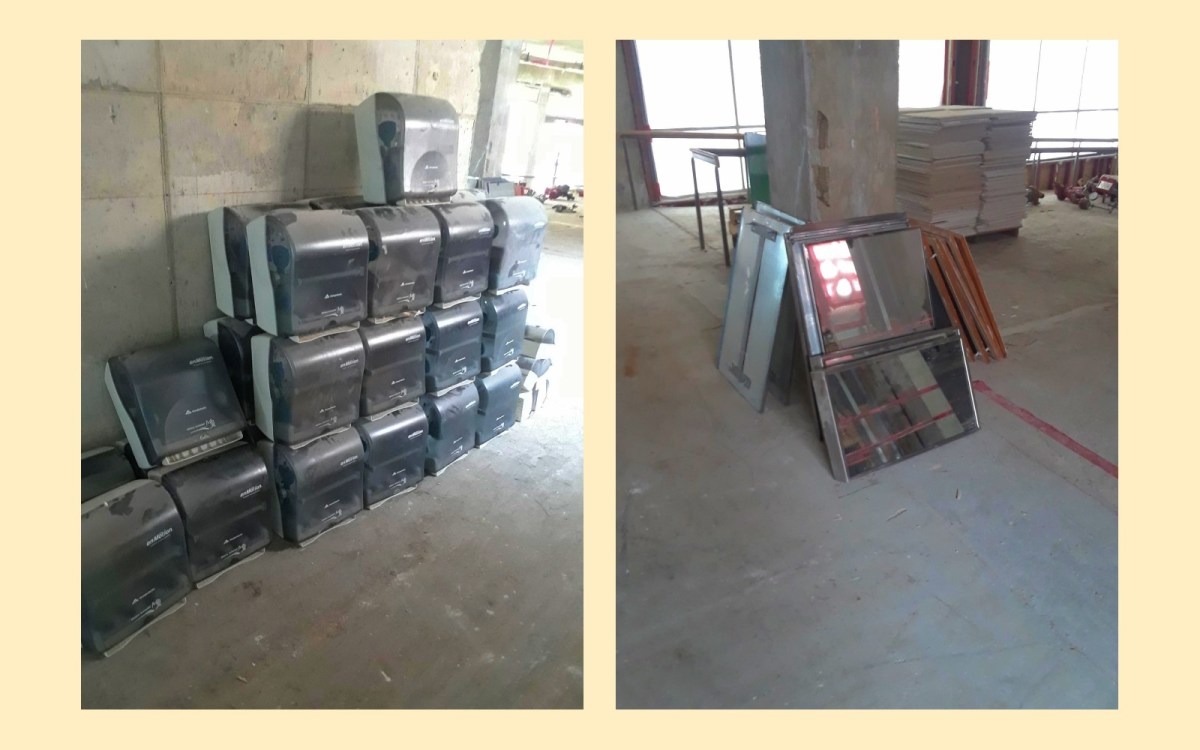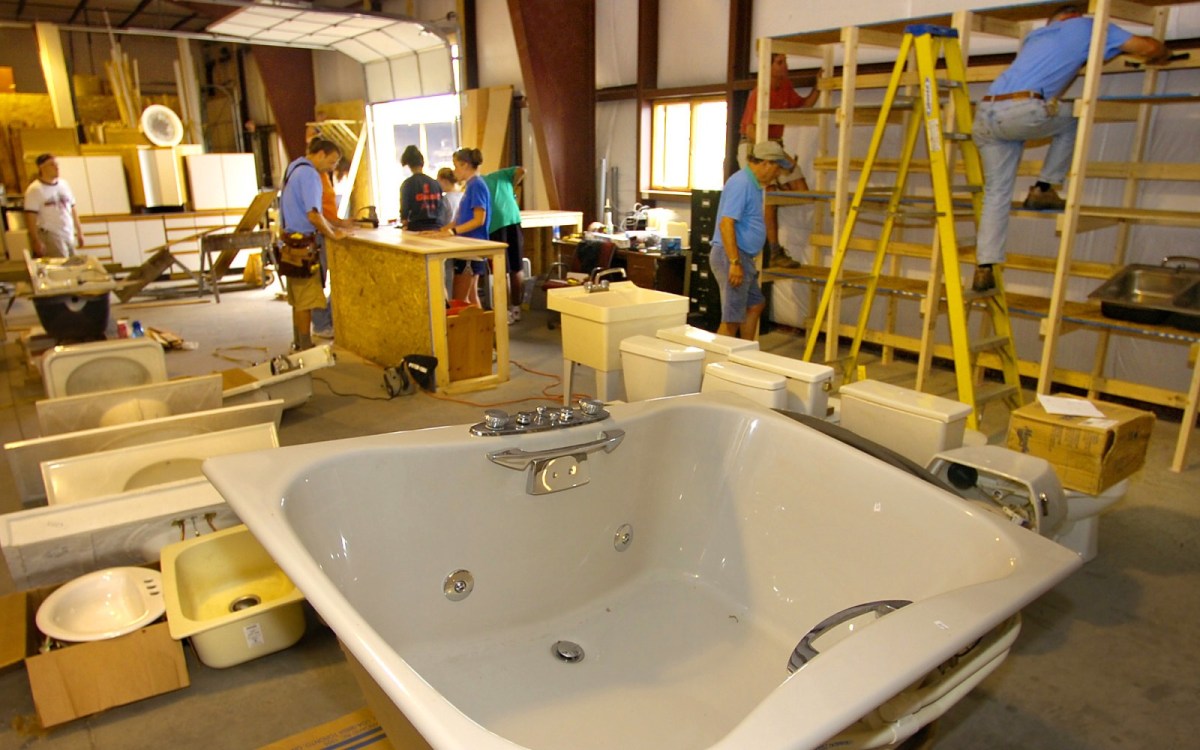
The vision
Contractors at the Salvaged Materials Market ignored the stack of misshapen supplies, but Carmelo saw the makings of his masterpiece in that pile. The sculptor spent an hour scrounging to gather all he needed, then pushed his cart of discarded treasures out the door.
Every footstep fed his mind as they led to a four-story makerspace graffitied in the mismatched styles of his community’s cultures. Carmelo floated to his curtained-off corner, spilled his haul, and began to pick and place parts on his piece-in-progress in a dance that brought his dream from the dark of mind into the studio light.
— a drabble by Syris Valentine
The spotlight
We tend to think of buildings as semipermanent structures. Once they go up, decades or even centuries pass before they come down. But when they do, it’s usually under the weight of wrecking balls and sledgehammers. The shattered remains of the structures that once sheltered us are then often cast into a landfill. Each year, nearly 150 million tons of this debris piles up in dumps in the U.S. alone.
Globally, the act of erecting new buildings and tearing down old ones consumes roughly a third of all resources extracted from the environment every year and produces just under a third of all the world’s waste. But several cities across the U.S. have begun to push the construction sector toward practices that keep materials out of the landfill. The goal: Reuse parts of old buildings in new ones, and recycle the rest.
In 2016, Portland, Oregon, became the first city in the country to institute a deconstruction ordinance, requiring that all single-family homes built before 1940 and slated for removal be deconstructed — that is, taken apart board by board — so their materials can be salvaged for reuse. Since then, more than half a dozen cities from San Antonio to Pittsburgh have followed Portland’s example.
“Ideally, what is being pulled out of these houses is being used for their same purpose,” says Stephanie Phillips, San Antonio’s deconstruction and circular economy program manager. Like Portland’s, San Antonio’s 2022 ordinance specifically mandates that old, historic homes be deconstructed if they’re coming down.
That’s at least in part because the best, and sometimes only, way to get the right materials to rehab historic buildings is from a different home built in the same period. As Phillips says, “Rehabbing buildings is looked at as the pinnacle of climate-wise building.”

Contractors at work deconstructing a home as part of a training in San Antonio in late 2022. City of San Antonio Office of Historic Preservation
A small number of cities go even further. Boulder, Colorado, is one of only two cities nationwide (the other being Palo Alto, California) that requires deconstruction of any and every building slated to come down, regardless of age and whether it’s residential or commercial. Boulder’s ordinance also includes what’s known as a “mandatory minimum.” At least 75 percent of the total weight of a building must be diverted from landfill through either reuse or recycling.
![]()
Jackie Kirouac-Fram, executive director of the Portland-based nonprofit ReBuilding Center, believes that a mandatory minimum is necessary to achieve the intent of these deconstruction ordinances: salvaging high-quality materials that homeowners, builders, and craftspeople can then access at affordable rates. Without this requirement, Kirouac-Fram says, Portland has seen particularly low rates of salvage. (Official figures aren’t available, and city representatives didn’t respond to a request for comment.)
While San Antonio also lacks a mandatory minimum, Phillips says the city’s contractors have on average recovered 70 percent of a given building’s weight, with over half of the recovered materials going to reuse. Phillips attributes these figures to the thorough, city-sponsored training contractors must go through in order to qualify for San Antonio’s list of certified deconstruction contractors.

Lumber, bricks, doors, and other reclaimed materials are piled on the side of a deconstruction training site in San Antonio. City of San Antonio Office of Historic Preservation
Meanwhile, in Boulder, despite its mandatory minimum, the city has not provided much training for the local workforce or established certification requirements, according to Emily Freeman, the city’s policy advisor on the circular economy. As a result, some contractors may exploit loopholes to meet the requirements without salvaging so much as a single two-by-four, and property owners have few tools to evaluate the bids they receive. They’re being asked to compare “apples to kiwis,” Freeman says.
In the worst example she has seen to date, a contractor used the foundation — the heaviest part of a building — as well as patio furniture and mulched trees on the property to meet the requirement to divert 75 percent of the building’s weight.
This reveals another challenge when it comes to mandatory minimums: Such requirements often don’t differentiate between reuse — the ideal form of waste diversion — and recycling. For instance, if lumber isn’t sorted and stored so it can later be picked up and incorporated into a new project, it might instead be sent through a chipper and processed into particleboard.
To address these problems, Freeman and her colleagues are looking to revise and strengthen some of Boulder’s deconstruction practices, which could include hosting trainings and establishing a certified contractors list, similar to San Antonio’s, to ensure everyone has the same playbook of best practices. Freeman hopes that these types of changes would help Boulder to achieve the vision she briefly saw realized in 2023, when the city deconstructed an abandoned hospital. Of the 65-million-pound building, the city recycled or salvaged 60.8 million pounds, or 93.5 percent of the building’s weight. This included structural steel that has found its way into two new city-owned buildings: a fire station and a golf course clubhouse.
![]()
Taking salvaged materials and getting them into other buildings is what organizations like Kirouac-Fram’s ReBuilding Center aim to facilitate. It stores salvaged materials that Portlanders can purchase at low-to-no cost. San Antonio has launched its own Material Innovation Center to find the next best use for salvaged materials, including bus shelters, garden beds, and affordable housing repairs.

Paper towel dispensers and mirrors are gathered inside the abandoned Boulder hospital during its deconstruction. City of Boulder
But a final challenge remains in many of these cities: getting contractors to use salvaged materials in their projects. In some cases, the problem is a matter of ease and inventory; contractors don’t want to waste time browsing stacks of mismatched materials when they may not find what they need. In other cases, builders still need to be convinced that giving old materials a second life in new construction won’t compromise a building’s integrity.
Boulder has been struggling to close this piece of the reuse loop. Though the city has incorporated many of the metal beams extracted from the old hospital into new city-owned properties, some leftover steel remains. City officials are still in talks with builders in Boulder to find someone to take what’s left.
“It’s just a matter of convincing the construction world that reused steel is going to be solid,” Freeman says. She hopes that as people see other buildings standing strong with salvaged steel, they’ll start to use it in projects of their own.
— Syris Valentine
More exposure
- Read: more about the rise of deconstruction (Texas Climate News)
- Read: more about the development of Portland’s ordinance, the first in the nation (The Municipal)
- Read: about a startup using mushrooms to recycle building waste (Forbes) (and also on last year’s Grist 50)
- Read: an advice article about repurposing the discards of a home remodel (Grist)
- Read: about the problem of discarded clothing that plagues Chile (Grist)
A parting shot
Habitat for Humanity, the affordable housing organization, sells used home goods at its ReStores. Shoppers can find more than just furniture — the stores often stock building supplies like doors and windows, and even toilets, sinks, and tubs. Here, volunteers arrange plumbing supplies (including a gigantic tub) in a store that opened in 2006 in Portland, Maine.




